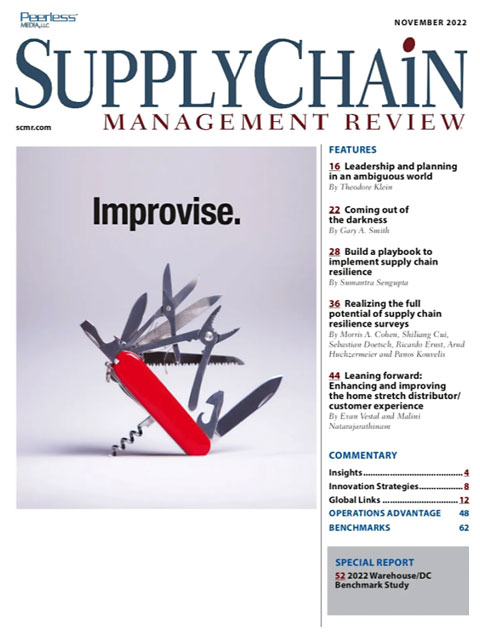Sorry, but your login has failed. Please recheck your login information and resubmit. If your subscription has expired, renew here.
November 2022
Are you resilient? It’s not an idle question. If there’s one word that I’ve heard at every supply chain event I’ve attended this year, its resilience. It is, of course, in response to the last few years in supply chain management. I think its fair to say that supply chains have been knocked to the canvas more times than Rocky. What has become clear as we do our post-pandemic reviews is that the firms that demonstrated the ability to get up off the canvas and keep punching were those that invested in resiliency before the pandemic—even if they didn’t use that term. Browse this issue archive.Need Help? Contact customer service 847-559-7581 More options
Nowadays, we often hear the question: “When will we get back to business as usual?” COVID has totally turned our world upside down, leaving confusion, disruption, shortages and increased costs in its wake. Over the course of two years, virtually every activity where people gathered was shut down, including restaurants, bars, movie theatres, stadiums, and even shopping malls. Thousands of businesses closed their doors. Weddings and funerals were postponed. Cities became ghost towns—literally overnight—as people stayed indoors and avoided contact with others.
Looking back now, it was in some ways almost comical. I remember seeing my neighbors, a young married couple, in the hallway of our apartment building covered from head to toe in PPE and spraying and wiping down every item they purchased at a grocery store before they would take them into their apartment.
But we learned. Soon grabbing a face mask as you left the house became second nature. So did frequent hand washing and social distancing. Then in December 2020 the first vaccines became available. Over time, as people were vaccinated, restaurants and bars were allowed to re-open for eat-in customers and we relaxed the requirement to wear masks—at least until the rise of the Delta and Omicron variants.

This complete article is available to subscribers only.
Log in now for full access or start your PLUS+ subscription for instant access.
SC
MR
Sorry, but your login has failed. Please recheck your login information and resubmit. If your subscription has expired, renew here.
November 2022
Are you resilient? It’s not an idle question. If there’s one word that I’ve heard at every supply chain event I’ve attended this year, its resilience. It is, of course, in response to the last few years in… Browse this issue archive. Access your online digital edition. Download a PDF file of the November 2022 issue.Nowadays, we often hear the question: “When will we get back to business as usual?” COVID has totally turned our world upside down, leaving confusion, disruption, shortages and increased costs in its wake. Over the course of two years, virtually every activity where people gathered was shut down, including restaurants, bars, movie theatres, stadiums, and even shopping malls. Thousands of businesses closed their doors. Weddings and funerals were postponed. Cities became ghost towns—literally overnight—as people stayed indoors and avoided contact with others.
Looking back now, it was in some ways almost comical. I remember seeing my neighbors, a young married couple, in the hallway of our apartment building covered from head to toe in PPE and spraying and wiping down every item they purchased at a grocery store before they would take them into their apartment.
But we learned. Soon grabbing a face mask as you left the house became second nature. So did frequent hand washing and social distancing. Then in December 2020 the first vaccines became available. Over time, as people were vaccinated, restaurants and bars were allowed to re-open for eat-in customers and we relaxed the requirement to wear masks—at least until the rise of the Delta and Omicron variants.
SC
MR


Latest Supply Chain News
Latest Podcast

 Explore
Explore
Business Management News
- U.S.-bound containerized import shipments are up in June and first half of 2024
- Expand supply chain metrics to cover the complete customer experience
- When disaster strikes, the supply chain becomes the key to life
- Leadership development for supply chain leaders
- A smarter approach to sustainability is vital for healthy, resilient supply chains
- When the scales tilt: Making vaccine access work for all
- More Business Management
Latest Business Management Resources

Subscribe

Supply Chain Management Review delivers the best industry content.

Editors’ Picks





